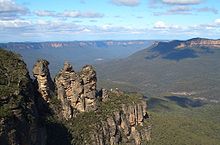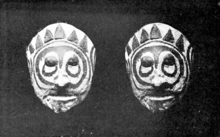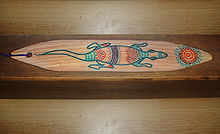Dream time

The term dreamtime (English Dreamtime or Dreaming ) is to reflect the central concept of the mythology of all Australian Aborigines and their ethnic religions , whereby the translation is misleading. The dreamtime legends deal with the universal, space- and timeless world from which the real present emerges in an incessant creation process in order to "fill" the dreamtime with new historical events. This all-encompassing spiritual fabric thus explains how everything came about and establishes the unwritten laws by which the Aborigines live. According to her belief, the events of the dream time manifest themselves in landmarks such as rocks, springs and other natural phenomena.
etymology
The British anthropologist Walter Baldwin Spencer and his Australian colleague Francis James Gillen translated the word Alcheringa the Central Australian language Arrernte with dreaming , which in the German with Dreamtime was played. However, the terms dreaming or dream time are misleading because they are reminiscent of the dream . The dream time has little to do with dreaming in sleep.
For the Aborigines, dream time is more about the “ spiritual, natural and moral order of the cosmos ”, and dreaming in this context means the collective ability to understand and use the world and its contexts correctly, the mythical world in a frame reflecting on a cult act, as well as possessing vitality. This can also be associated with normal , individual dreaming.
In another Central Australian language, the Pitjantjatjara , the dream time is called tjukurrpa . Other Aboriginal languages have their own terms for dream time, but they always mean the same thing. " The dreamtime is given orally in stories [exclusively] ".
General dreamtime worldview

The various terms in the Australian languages which are translated as “dream time” denote the idea of a space- and timeless source of existence, which could be described as “a continuous presence of creation without a beginning” . In the past there are only the events and experiences of this world ( "dreams" or " dream paths " ), which have had an effect on the dream time since time immemorial and which constantly change it in a timeless process. All beings, but also the things of inanimate nature, have their origin and their counterpart ( ancestral beings ) in the dreamtime. In contrast to the beings and events of this world, the beings and events of the dreamtime are, however, on an equal footing and at the same time side by side with everything that has happened so far. The dreams of this world are identical with the life energy of the people as well as the animate and inanimate nature, which constantly expand the dream time. The dreamtime - the sacred ongoing presence of creation - is considered to be the actual reality.
According to the imagination of the Aborigines, Clever Men can contact the dreamtime and its characters at any time (especially in holy places) through certain rituals and ceremonies.
It is the primeval beings of this creation story (such as the Wondjina depicted on rock and cave paintings ) who shaped the mountains, the rivers, the sea and the sky, gave their names to the animals and plants and gave the people, as heroes of culture, weapons, tools and laws brought. These mythical beings - which vary significantly from tribe to tribe - are referred to by some authors as spirits, by others as high gods (→ Australian high gods ) . Although they are regarded as heavenly beings, since they rose from earth to heaven after the transformation and order of the world, they are neither causal creators nor do they intervene in the fate of people. In this respect, they are generally not worshiped.
A central figure in many dreamtime concepts is the rainbow serpent , because it “ is the amalgamation of two important principles that represent the unity of spirit and matter. “In some tribes, the central role is also played by a mythical kangaroo or waran .
Probably since the colonization of Australia 40,000 or more years ago, people began to tell of the creation of the world in Dreamtime legends - which were passed down orally .
The dream time and its essence is also the origin for all rules of human coexistence, for law and order. The social rules are derived from the dream time, with violations of the code of conduct being sanctioned. Nevertheless, the dream time is not an unchangeable moral authority, but “learns” from the experiences of this world. There is nothing that is not related to the dreamtime. " In the imagination of the Aborigines, a" dreaming landscape "is an embodiment of mystical realities that are difficult to explain with words ".
The Aborigines believe that their immortal soul is a "spark" of their ancestral beings from the dreamtime, which returns to the dreamtime after the death of a being. In addition, this spark represents the unbroken connection to the dream time, which can be stimulated by certain rituals. These ancestral beings are not idealized like god, but are flawed like every real being. Your life paths "saved" in the dream time are intended to serve as teaching pieces for personal and collective action.
According to Gerhard Leitner, there are three main approaches to the "dreamtime worldview":
- Since there are regional and personal dream times, the personal dream times are integrated into the larger regional environment, the country. This embedding comes about through the paternal line. The bond with the country is so strong that people feel that they belong to the country and not the other way around.
- The dream time is not questioned. It is evident, there are hardly any doubters.
- The dream time is godless, its central theme is the geography, which is revealed in the land binding. The events of the dreamtime are manifested in thousands of sacred landmarks that have become a kind of spiritual map of Australia over the millennia . They are “frozen references to past events” , and it is in such places that contact is made at the dream time. Knowledgeable Aborigines can relate these landmarks to the associated dreamtime events at any time. The country is therefore the central dreamtime figure and not a god. The country and the dream time of others are respected. All dream times - better dream time paths - are linked together. The dream paths ( songlines ) - this term was used by the British writer Bruce Chatwin (1940–1989) - mean that nobody possessed the entire knowledge of the dream time and that this individual knowledge was and is put together in periodic rites and ceremonies.
The knowledge is not accessible to everyone, but only to selected carriers of the community. It's a secret. There were prominent personalities in the groups, the tribal leader, the medicine man (clever man) and the judge (law man), the elders of the group, who passed this knowledge on. This knowledge was differentiated between women and men. Nor did it mean that the person in question held a prominent position in the group. The knowledge of women was not accessible to men and vice versa.
The judgment was passed by the elder of the group and wrong was punished. It was either immediate sanctions or negotiations; a fight could also be arranged. If the judge, der law man , pointed at the condemned person with a bone, this amounted to an exclusion from the group. Exclusion from the group meant that he had little chance of survival in the wild ( outback ) on his own .
Ideas of the soul and the hereafter
The traditional Aborigines usually have the idea of three soul stages in the course of life: the spirit-child-soul, the life soul and the dead soul; whereby the names are very different. Children come into possession of their soul when the father receives a child's revelation in a dream or in a trance and then transmits this to the mother through a magical act (e.g. by touching the tip of a lance). Knowledge of the dead soul and the afterlife is poor, as Australians avoid talking about the dead. Apparently very inconsistent ideas prevail here in the otherwise quite uniform dreamtime religion: From a final extinction to permanent stays - for example on the "islands of the dead" - to intentional reincarnation in animals or humans, all imaginable ideas are present.
totemism
A particular expression of the dream time and of primary importance to the religious life of many tribes is totemism . Each person carries a totem, a totem figure or a totem reminder. “You impose certain obligations on the carrier. For example, if the totem is an animal, say a kangaroo, then that person will not hunt or eat it. He will not marry anyone who has this totem, even if other requirements are met. Totems create connections that go beyond kinship. ” In contrast to the cultural heroes and gods, they are never seen in heaven, but always connected to earth and earthly life. In prehistoric times, the totemahs slept under the then shapeless surface of the earth before they came to the surface at water holes, through springs or swamps, only to submerge again or to transform themselves into sacred objects - preferably stones. The places of their earthly appearance are considered sacred; the ancestors of the totems are ritually venerated on them. The totem animals or plants represent the connection of a group to the totemans. This group totem is the basis of the extremely complicated exogamic marriage regulations.
The ritual culture of the tribes with totemism forms the basis of the religious cult . The rites , accompanied by songs and dances, are considered to have been founded by the totem ancestors and make people identical with these ancestors. Young men are entitled to participate in esoteric cult acts that are forbidden for women after completing the initiation rites through which they are accepted into the community of men. These rites are associated with great hardships and are considered sacrificial acts . The painful incision of the scar was generally part of its execution. This was very widespread, but not on the whole continent. While there is generally a strict ban on eating the totem, eating the totem plant or animal can be ritually permitted or even required. The presence of the dead Dunning is the hum of the bullroarers experienced (see also: tjurunga ) .
Individual religious totemism is most pronounced in central and northern Australia, while in the more southern and eastern tribes there is often a mythologization within the clan communities that lead to ideas of cultural heroes and demiurges that do not exist in the northern and central tribes.
Australian high gods?
Especially the older ethnology looked for evidence around the world , for example with regard to the primordial monotheism thesis, that high gods were found in all religions who supposedly represented the Christian God. In the history of religion, heaven gods are characteristic of belief in high gods. In Australia, too, people believed they would find something. In fact, with some tribes there is a "supreme being" that could be called God. However, this interpretation is still controversial with regard to overly “targeted translations” from the native languages. Today they are viewed more as dreamtime beings, ancestors, or cultural heroes.
- Northwest: Walanganda (“belonging to heaven”), who rose to heaven at the end of primeval times as ruler of all spirit beings. He is recognized in the Milky Way.
- Northwest, especially Kimberley: Galalang , who is said to have given the people the best land, the most beautiful language and a long life. Founder of monogamy and guardian of moral laws.
- New South Wales: Djaramulun ( alter ego made from man and eagle falcon), a thunderstorm god who rides on thunder clouds and hurls stone axes as lightning.
- West and Central Victoria: Bundjil .
- New South Wales: Baiami , often named as the father of Djaramulun. Mostly known as a cultural hero.
See also
literature
- Wally Caruana: Aboriginal Art. Lichtenberg-Verlag, Munich 1997, ISBN 3-7852-8403-9 .
- Bruce Chatwin: Dream Paths . Novel. Carl-Hanser-Verlag, Munich 1990, ISBN 978-3-596-10364-5 .
- James Cowan: Dreamtime Revelations. The Aboriginal Spiritual Knowledge. Lüchow-Verlag, Stuttgart 2004, ISBN 3-363-03050-9 .
- Ursula Dreyer: Dreaming Tracks - search for traces. On the way to intercultural dialogues. Kleio Humanities, Bremen 2006, ISBN 3-9811211-1-2 .
- Gerhard Leitner: The Aborigines of Australia . Beck-Verlag, Munich 2006, ISBN 3-406-50889-8 .
- Anna Voigt and Nevill Drury: The Legacy of Dreamtime. Aboriginal life, myths and death . Delphi at Droemer, Munich 1998, ISBN 3-426-29045-6 .
Individual evidence
- ↑ a b c d e Anna Voigt and Nevill Drury: The Legacy of Dreamtime. Aboriginal life, myths and death.
- ↑ Caruana: Aboriginal Art. P. 10.
- ↑ Fritz Stolz : "1. Worldviews as an expression of religions. Pdf version, chapter 2.5.
- ↑ Cowan: Revelations. P. 40.
- ↑ a b c d e Günter Lanczkowski: The religion of the Australians, published in: Horst Balz et al. (Hrsg.): Theologische Realenzyklopädie , Volume 4: “Arcandiscipline - Autobiography”, here: Australia, Section 2. Walter de Gruyter, Berlin, New York 1979, ISBN 978-3-11-019098-4 . Pp. 755-768.
- ↑ Cowan: Revelations. P. 35.
- ↑ Leitner: The Aborigines. P. 40.
- ↑ Cowan: Revelations. P. 29.
- ↑ Leitner: The Aborigines. P. 37ff.
- ↑ Leitner: The Aborigines. P. 41.
- ↑ Tokarew, pp. 46 f., 59, 70 f.
- ↑ Richard Nile, Christian Clerk: World Atlas of Ancient Cultures: Australia, New Zealand and the South Pacific. History art life forms. Christian Verlag, Munich 1995, ISBN 3-88472-291-3 . P. 39.
- ^ Corinna Erckenbrecht: Traditional religions in Australia. In: Harenberg Lexicon of Religions. Harenberg, Dortmund 2002, ISBN 3-611-01060-X . Pp. 924-925.
- ^ Corinna Erckenbrecht: Traditional religions in Australia from A – Z. In: Harenberg Lexicon of Religions. Harenberg, Dortmund 2002, ISBN 3-611-01060-X . P. 929.


